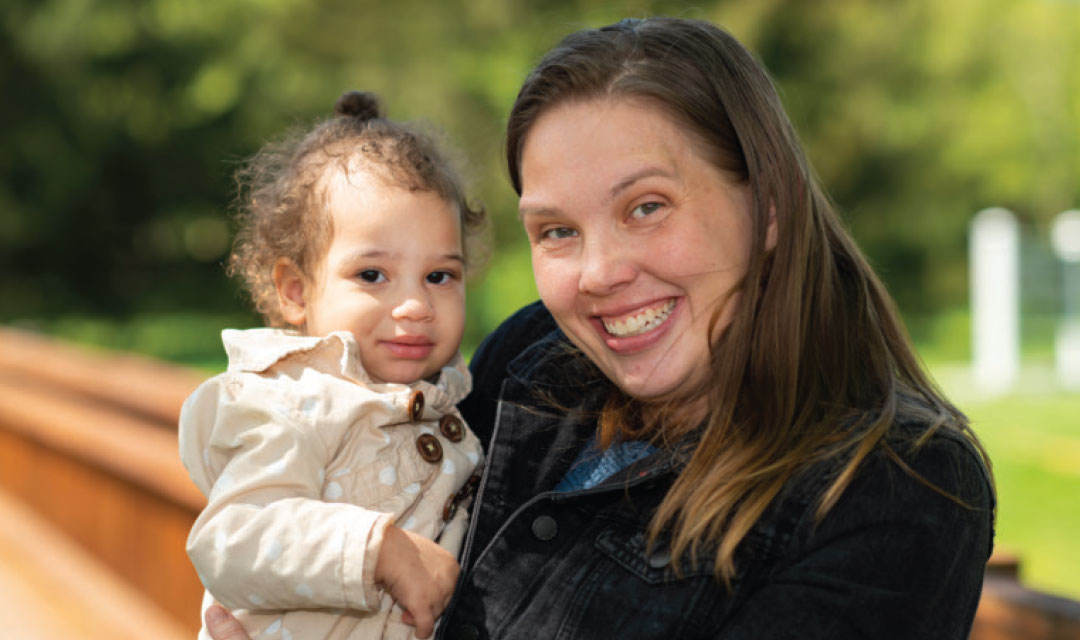A sophisticated, life-support therapy helped 18-month-old Emanta survive a severe case of the flu and collapsed lungs.

Emanta Adrien was very ill when she arrived at The Bristol-Myers Squibb Children’s Hospital (BMSCH) at Robert Wood Johnson University Hospital (RWJUH) last February. The toddler, just 18 months old, was transferred from a Trenton-area hospital with a severe case of the flu. The common illness causes body aches, coughing and fatigue, and in some cases can lead to serious complications. In Emanta’s case, the virus had affected her lungs, and she was struggling to breathe. She was placed on a ventilator, but after improving for a day or so, her condition deteriorated.
“Emanta developed holes in her lungs,” says Shaheen Timmapuri, MD, a surgeon at BMSCH. She had a condition known as pneumothorax, also called a collapsed lung, which occurs in some patients who receive mechanical ventilation. Air leaks into the space between the lungs and chest wall creating pressure that causes the lungs to collapse, which can be life-threatening. Leaving Emanta on the ventilator was not an option. “We needed to let her lungs rest,” says Dr. Timmapuri. Emanta’s mother, April Johnson, remembers how scared she was. “We had to take the situation minute by minute and hour by hour,” she says. “I said to the doctors, ‘Please just save my daughter, just save my daughter.’”
Fortunately, a team at BMSCH had been trained to manage this dire situation, and Emanta became the first pediatric patient at the hospital to receive extracorporeal membrane oxygenation (ECMO). This form of life support assumes the roles that the lungs and heart normally play in breathing, allowing these critical organs time to recover from damage caused by disease. Dr. Timmapuri, who is surgical director of the Pediatric ECMO Program at BMSCH, says the procedure was likely Emanta’s last hope. “She probably would not have survived the day,” says Dr. Timmapuri. “ECMO saved her life.”
A Lifesaving Treatment
 Similar in concept to the cardiopulmonary (“heart-lung”) bypass machines used during some major surgeries, ECMO is designed to be deployed in an intensive care unit (ICU) instead of an operating room. Healthy lungs take in oxygen, which is delivered through the bloodstream to the heart. In turn, the heart pumps blood through the arteries to cells, which need oxygen to function. In exchange, cells release carbon dioxide, which travels back to the lungs to be exhaled. A patient suffering from lung failure may struggle to provide enough oxygen to the body or remove carbon dioxide. ECMO can take over this role, allowing the lungs to expend energy on healing instead. ECMO is also used to support failing hearts (see “Help For a Serious Heart Problem” below).
Similar in concept to the cardiopulmonary (“heart-lung”) bypass machines used during some major surgeries, ECMO is designed to be deployed in an intensive care unit (ICU) instead of an operating room. Healthy lungs take in oxygen, which is delivered through the bloodstream to the heart. In turn, the heart pumps blood through the arteries to cells, which need oxygen to function. In exchange, cells release carbon dioxide, which travels back to the lungs to be exhaled. A patient suffering from lung failure may struggle to provide enough oxygen to the body or remove carbon dioxide. ECMO can take over this role, allowing the lungs to expend energy on healing instead. ECMO is also used to support failing hearts (see “Help For a Serious Heart Problem” below).
To administer ECMO, a doctor inserts a tube called a cannula into a large vein, usually in the patient’s neck or groin. Blood is withdrawn from the body and passed into an artificial lung, which removes carbon dioxide and adds oxygen. Then, a pump returns the blood to the body through a cannula in a vein or artery.
A Multidisciplinary Effort
BMSCH didn’t yet offer ECMO when Dr. Timmapuri arrived at RWJUH in 2016. By 2017, Dr. Timmapuri had assembled a diverse group of colleagues who would be trained to deliver ECMO to children, making BMSCH one of only two hospitals in New Jersey with such a program. “This is a multidisciplinary effort,” says Dr. Timmapuri, noting that pediatric surgeons, critical care physicians, nurses, pharmacists and respiratory therapists play key roles. Training took place during the past year.
All patients who receive care in the Pediatric Intensive Care Unit (PICU) at BMSCH have a dedicated nurse, but ECMO patients are also attended by an ECMO nurse specialist who monitors the patient’s oxygen levels and other vital signs and watches for evidence of bleeding—a risk with ECMO, since patients are given blood thinners to prevent clots.
Patients may remain on ECMO for hours, days and even weeks. Emanta was connected to the ECMO machine for five days before her lungs began healing and she was weaned off. After spending 18 days in the PICU, she was transferred to the general pediatric unit. Later, Emanta was sent to PSE&G Children’s Specialized Hospital for rehabilitation. “She has recovered quite well,” says Dr. Timmapuri.
Indeed, Emanta is an active toddler, and April is so grateful that she is now donating blood on a regular basis. “The team worked around the clock to make sure Emanta received the best care,” she says. “The physicians and nurses genuinely care about their patients. I thank them from the bottom of my heart.”
Help for a Serious Heart Problem
Patients who need ECMO “are the sickest of the sick,” says Leonard Lee, MD, a cardiac surgeon at Robert Wood Johnson University Hospital (RWJUH) and Chair of the Department of Surgery at Rutgers Robert Wood Johnson Medical School. That means patients with lung failure, like Emanta Adrien, or those with cardiogenic shock, in which the heart is unable to pump enough blood throughout the body. (This often occurs in people who suffer a massive heart attack.)
In patients with cardiogenic shock, ECMO keeps the patient’s blood pumping through the body until surgeons can repair the heart with surgery or a device, such as an implanted pump. RWJUH receives referrals for ECMO from hospitals throughout the region.
To learn more about ECMO at The Bristol-Myers Squibb Children’s Hospital at Robert Wood Johnson University Hospital, visit www.rwjbh.org/bmschecmo.